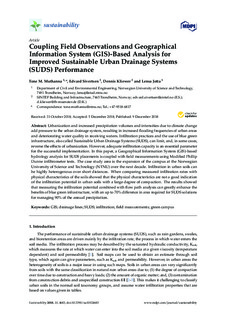| dc.contributor.author | Muthanna, Tone Merete | |
| dc.contributor.author | Sivertsen, Edvard | |
| dc.contributor.author | Kliewer, Dennis | |
| dc.contributor.author | Jotta, Lensa | |
| dc.date.accessioned | 2019-02-28T14:53:30Z | |
| dc.date.available | 2019-02-28T14:53:30Z | |
| dc.date.created | 2018-12-11T11:19:28Z | |
| dc.date.issued | 2018 | |
| dc.identifier.issn | 2071-1050 | |
| dc.identifier.uri | http://hdl.handle.net/11250/2588122 | |
| dc.description.abstract | Urbanization and increased precipitation volumes and intensities due to climate change add pressure to the urban drainage system, resulting in increased flooding frequencies of urban areas and deteriorating water quality in receiving waters. Infiltration practices and the use of blue green infrastructure, also called Sustainable Urban Drainage Systems (SUDS), can limit, and, in some cases, reverse the effects of urbanization. However, adequate infiltration capacity is an essential parameter for the successful implementation. In this paper, a Geographical Information System (GIS)-based hydrology analysis for SUDS placements is coupled with field measurements using Modified Phillip Dunne infiltrometer tests. The case study area is the expansion of the campus at the Norwegian University of Science and Technology (NTNU) over the next decade. Infiltration in urban soils can be highly heterogenous over short distances. When comparing measured infiltration rates with physical characteristics of the soils showed that the physical characteristics are not a good indication of the infiltration potential in urban soils with a large degree of compaction. The results showed that measuring the infiltration potential combined with flow path analysis can greatly enhance the benefits of blue green infrastructure, with an up to 70% difference in area required for SUDS solutions for managing 90% of the annual precipitation. | nb_NO |
| dc.language.iso | eng | nb_NO |
| dc.publisher | MDPI | nb_NO |
| dc.rights | Navngivelse 4.0 Internasjonal | * |
| dc.rights.uri | http://creativecommons.org/licenses/by/4.0/deed.no | * |
| dc.title | Coupling Field Observations and Geographical Information System (GIS)-Based Analysis for Improved Sustainable Urban Drainage Systems (SUDS) Performance | nb_NO |
| dc.type | Journal article | nb_NO |
| dc.type | Peer reviewed | nb_NO |
| dc.description.version | publishedVersion | nb_NO |
| dc.source.journal | Sustainability | nb_NO |
| dc.source.issue | 10 | nb_NO |
| dc.identifier.doi | 10.3390/su10124683 | |
| dc.identifier.cristin | 1641552 | |
| dc.relation.project | Norges forskningsråd: 237859 | nb_NO |
| dc.description.localcode | © 2018 by the authors. Licensee MDPI, Basel, Switzerland. This article is an open access article distributed under the terms and conditions of the Creative Commons Attribution (CC BY) license (http://creativecommons.org/licenses/by/4.0/). | nb_NO |
| cristin.unitcode | 194,64,91,0 | |
| cristin.unitname | Institutt for bygg- og miljøteknikk | |
| cristin.ispublished | true | |
| cristin.fulltext | original | |
| cristin.qualitycode | 1 | |

